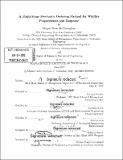A multi-stage stochastic ordering method for wildfire preparedness and response
Author(s)
McCleneghan, Megan Rose, author.
Download1373629276-MIT.pdf (12.45Mb)
Other Contributors
Sloan School of Management,
Massachusetts Institute of Technology. Department of Mechanical Engineering.
Terms of use
Metadata
Show full item recordAbstract
Following an unprecedented wildfire season in 2017, management of Sierra Gas & Electric (SG&E), an undisclosed utility company, issued a new standard directing that all new and replacement electric transmission line (T-Line) poles be made from steel wherever possible to mitigate liability. This new standard necessitates that some inventory be held locally in anticipation of emergencies and quality issues as steel poles have significantly longer lead times than wood. The variability of poles makes ordering for an emergency inventory difficult, as steel poles come in more than 60 common strength/length combinations. This thesis focuses on assessing the risk wildfire poses to SG&E's wood T-Line poles, and simulating an estimated yearly demand to determine order quantities that optimize pole replacement preparedness. In general, this work presents a two-stage process for determining necessary inventory levels for non-perishable products when the products needed change with the location of an event. A Markov Chain Monte Carlo simulation was developed using empirical sampling of prior fire data over 2,000 iterations to create simulated wildfires throughout the state of California. Combining this with geospatial analysis allowed for modeling of approximate distributions of SG&E poles in the footprints of fires. Given the probabilistic demand for poles of different types, the two-stage process was defined as before an emergency has occurred and after, once the location of a fire is known. Optimization problems were set up based on both aggregate and location specific data to inform the service levels used for ordering poles at each stage. This model offers realistic insight into how the varied nature of SG&E's pole infrastructure across the state effects ordering decisions, as well as how the company can leverage its extensive geospatial data and forecasting abilities to make ordering decisions.
Description
Thesis: S.M. in Management Research, Massachusetts Institute of Technology, Sloan School of Management, 2019 Thesis: S.M., Massachusetts Institute of Technology, Department of Mechanical Engineering, 2019 Cataloged from PDF version of thesis. "The pagination in this thesis reflects how it was delivered to the Institute Archives and Special Collections. The Table of Contents does not accurately represent the page numbering"--Disclaimer page. Includes bibliographical references (page 83).
Date issued
2019Department
Massachusetts Institute of Technology. Operations Research Center; Massachusetts Institute of Technology. Department of Mechanical EngineeringPublisher
Massachusetts Institute of Technology
Keywords
Sloan School of Management,, Mechanical Engineering.